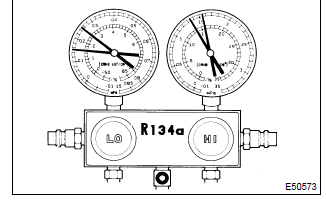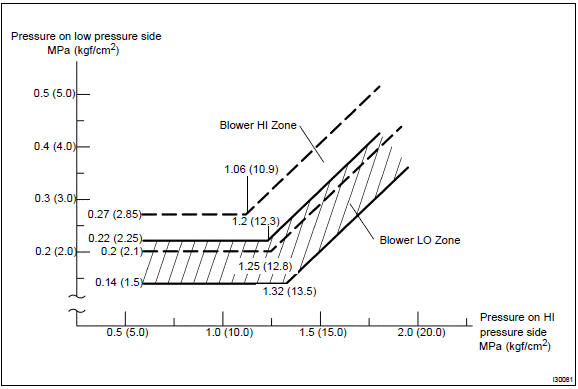Toyota Corolla (E120) 2002–2008 Repair Manual / Heater & air conditioner / Refrigerant / On–vehicle inspection
Toyota Corolla (E120): On–vehicle inspection
1. Inspect refrigerant pressure with manifold gauge set
- this is a method in witch the trouble is located by using
a manifold gauge set. Read the manifold gauge pressure
when the these conditions are established.
Test conditions:
- temperature at the air inlet with the switch set at recirc is 30 – 35 °c (86 – 95 °f)
- engine running at 1500 rpm
- blower speed control switch at ”hi” position
- temperature control dial at ”cool” position a/c switch on
- fully open doors

- Normally functioning refrigeration system.
Gauge reading:
low pressure side:
0.15 – 0.25 Mpa (1.5 – 2.5 Kgf/cm2) high pressure side:
1.37 – 1.57 Mpa (14 – 16 kgf/cm2)
- Moisture present in refrigeration system.

|
Symptom |
Probable cause |
Diagnosis |
Remedy |
| During operation, pressure on low pressure side sometimes become a vacuum and sometime normal | Moisture in refrigerating system freezes at expansion valve orifice causing a temporary stop of cycle, however, when it melts, normal state is restored. |
|
|
- Insufficient cooling

|
Symptom |
Probable cause |
Diagnosis |
Corrective actions |
|
Gas leakage in refrigeration system |
|
|
- Poor circulation of refrigerant

|
Symptom |
Probable cause |
Diagnosis |
Corrective actions |
|
Refrigerant flow obstructed by dirt in receiver | Receiver clogged | Replace condenser |
- Refrigerant does not circulate

|
Symptom |
Probable cause |
Diagnosis |
Corrective actions |
|
|
Refrigerant does not circulate |
|
- Refrigerant overcharged or insufficient cooling of condenser

|
Symptom |
Probable cause |
Diagnosis |
Corrective actions |
|
|
|
|
- Air present in refrigeration system

|
Symptom |
Probable cause |
Diagnosis |
Corrective actions |
|
Air entered in refrigerating system |
|
|
- Expansion valve improperly

|
Symptom |
Probable cause |
Diagnosis |
Corrective actions |
|
Trouble in expansion valve |
|
Check expansion valve |
- Defective compression compressor

|
Symptom |
Probable cause |
Diagnosis |
Corrective actions |
|
Internal leak in compressor |
|
Repair or replace compressor |
Gauge readings (reference)

Other materials:
Using the interior lights
Interior lights list
Location of the interior lights
Rear interior light
Front interior/personal lights
Operating the interior
lights
■ Front
Turns the door position on/off
When a door is opened while the
door position is on, the lights turn
on.
Turns the lights on/off
■ Rear
Turns ...
Warning light and warning buzzer list
*1: Parking brake engaged warning buzzer:
*2: Open door warning buzzer:
*3: Vehicles with a drive monitor display
*4: Vehicles with a multi-information display
*5: Driver’s seat belt buzzer:
Vehicles without a smart key system: The driver’s seat belt buzzer sounds to alert
the d ...
On–vehicle inspection
1. Install lspv gauge (sst) and bleed air
remove the bleeder plugs from the front and rear brake cylinder.
install the lspv gauge (sst), and bleed the air.
Sst 09709–29018
2. Raise master cylinder pressure and check rear wheel cylinder pressure
Hint:
when inspectin ...


